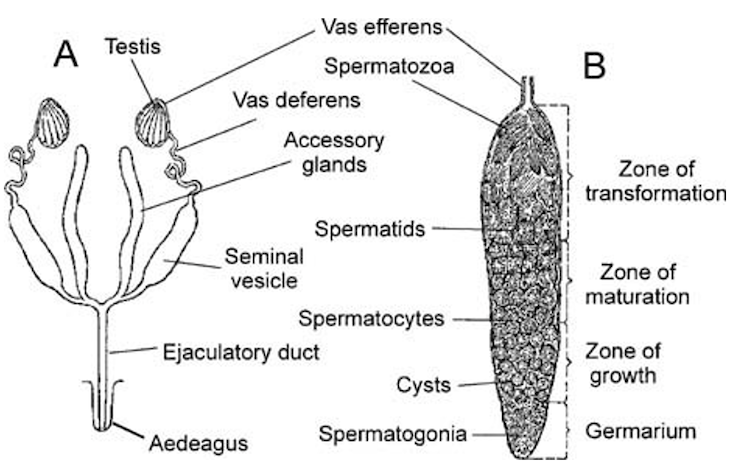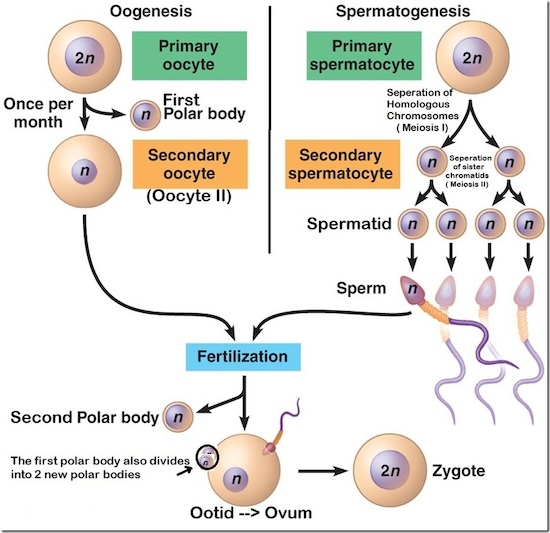👩❤️👩 Reproductive System
Male and Female Reproductive Systems, Types of Reproduction in Insects
Which of the following statment is incorrect?
- Insects are generally bisexual.
- The other types are:
- Gynandromorph: (Sexual mosaic) Abnormal individual with secondary sexual characters of both male and female. e.g. mutant Drosophila.
- Hermaphrodite: Male and female gonads are present in one organism. e.g. Cottony cushion scale.
- But sometimes reproduction also occurs by parthenogenesis and hermaphroditism.
- The reproductive system is divided in to two parts namely internal genitalia and external genitalia.
- The external genitalia accomplish the union of two sexes and enable the female to deposit eggs.
Female Reproductive System

👉🏻 It consists of
- a pair of ovaries which possess number of ovarioles
- a pair of oviducts
- common oviduct / median oviduct
- spermatheca
- a pair of accessory glands
- bursa copulatrix or copulatory pouch or genital chamber or vagina.
Male reproductive system
👉🏻 Internal male reproductive organs consists of
- a pair of testis,
- a pair of vasa deferens,
- seminal vesicle,
- ejaculatory duct,
- accessory glands: These glands are called mushroom glands in cockroaches and mantids because of their appearance as mushrooms.
- genitalia
Physiology of reproduction

Types of Reproduction
- Insects are bisexual, they can undergo sexual reproduction for producing either the eggs (or) the young ones. However, they also reproduce by other means.
- Oviparity: Insects reproduce by laying eggs by the female on any substrate either singly (or) in mass (or) in groups which later hatch and produce the young ones. E.g.: moths and butterflies.
- Viviparity: It is the phenomenon of reproduction where the female gives birth to the young ones instead of laying eggs. Embryonic development is completed within the female and the embryo gets nourishment from the mother and produce the larva/young ones within the haemocoel. These young ones after some time emerges out from the mother, based on the source of nourishment.
- Parthenogenesis: It is the ability of the females to reproduce without fertilization / copulation with males. This usually occurs due to the genetic characters, due to heredity, failure in finding a mate, hormonal changes within the body and weather factors.
- Paedogenesis/Neoteny: It is a phenomenon where the immature insects or stages give birth to young ones. This usually occurs due to the hormonal imbalance. Most of the insects which reproduce by paedogenesis also reproduce by parthenogenesis. e.g.: cecidomyids.
- Polyembryony: It is a type of reproduction where insects reproduce by giving birth to two or more young ones instead of a single one, as two or more embryos are produced from a single egg. e.g.: endo parasitic Hymenoptera like platygaster.
- Hermaphroditism: It is a type of reproduction where both male and female gonads are present in the same individual. It may be a functional hermaphroditism as in case of Icerya purchsi (or) non-functional as in case of stonefly, Perla marginata
- Castration: It is a type of reproduction where the separation of the individuals occurs mainly due to the development of the reproductive organs. The insects with well-developed ovaries develop into females (queens), the insects with well-developed testis develop into males (drones) and insects with underdeveloped ovaries develop into workers. e.g.: social insects such as honeybees.
- Alternation of generation: Insects reproduce by parthenogenesis and bisexual reproduction by alteration of generations. e.g.: aphids which reproduce by parthenogenesis in summer and undergo sexual reproduction in winter.
References
- Insecta - Introduction: K.N. Ragumoorithi, V. Balasurbramani & N. Natarajan
- A General Textbook of Entomology (9th edition, 1960) – A.D. Imms (Revised by Professor O.W. Richards and R.G. Davies). Butler & Tanner Ltd., Frome and London.
- The Insects- Structure and Function (4th Edition, 1998) – R.F. Chapman. Cambridge University Press
- https://www.amentsoc.org/
- Researchgate
- Wikipedia
Which of the following statment is incorrect?
- Insects are generally bisexual.
- The other types are:
- Gynandromorph: (Sexual mosaic) Abnormal individual with secondary sexual characters of both male and female. e.g. mutant Drosophila.
- Hermaphrodite: Male and female gonads are present in one organism. e.g. Cottony cushion scale.
- But sometimes reproduction also occurs by parthenogenesis and hermaphroditism.
- The reproductive system is divided in to two parts namely internal genitalia and external genitalia.
- The external genitalia accomplish the union of two sexes and enable the female to deposit eggs.
Female Reproductive System

👉🏻 It consists of
- a pair of ovaries which possess number of ovarioles
- a pair of oviducts
- common oviduct / median oviduct
- spermatheca
- a pair of accessory …
Become Successful With AgriDots
Learn the essential skills for getting a seat in the Exam with
🦄 You are a pro member!
Only use this page if purchasing a gift or enterprise account
Plan
Rs
- Unlimited access to PRO courses
- Quizzes with hand-picked meme prizes
- Invite to private Discord chat
- Free Sticker emailed
Lifetime
Rs
1,499
once
- All PRO-tier benefits
- Single payment, lifetime access
- 4,200 bonus xp points
- Next Level
T-shirt shipped worldwide

Yo! You just found a 20% discount using 👉 EASTEREGG

High-quality fitted cotton shirt produced by Next Level Apparel